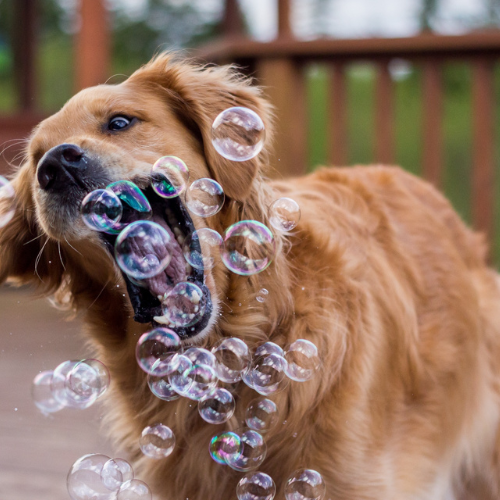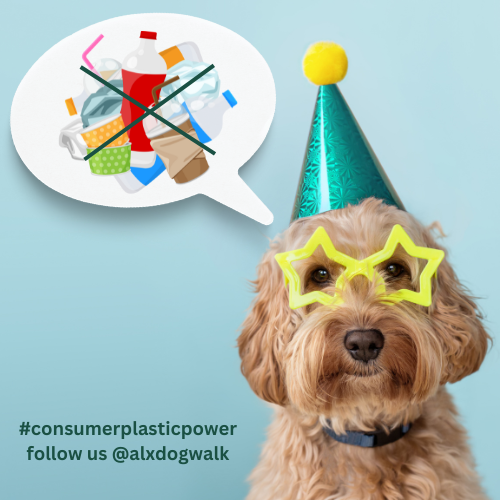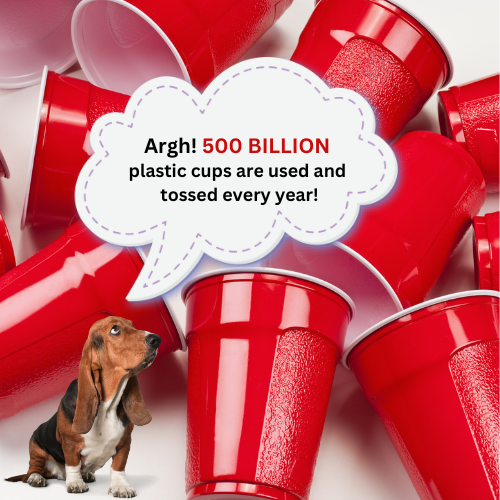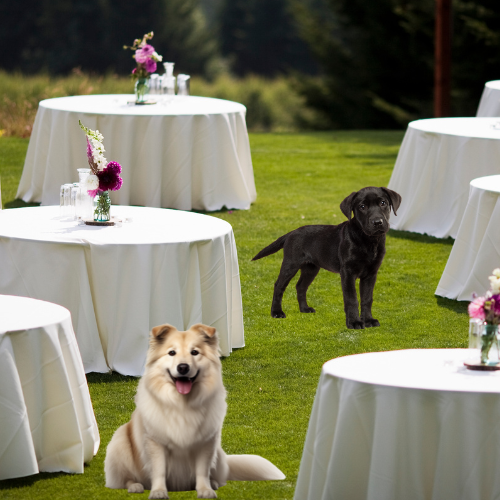#FunActivism

Looking to spark some action in your mission-driven organization? How about shaking things up with a little fun and humor! Introducing #FunActivism — a fresh and surprising way to energize your marketing. Curious? Dive into the article “Is Your Nonprofit Serious About Making Change? Consider Having Fun!” by Julie Chapman and Lisa Novick, featured on philanthropy.org. Let’s make change — and have fun doing it! Bark on!
Sustainable Parties

Planning an event that’s both beautiful and kind to the planet? It’s easier than you think! With a few thoughtful choices, you can create a stunning, eco-friendly table setting and provide guests with giveaways they’ll actually use, all while keeping plastic waste to a minimum. Let’s dive into sustainable alternatives that are as stylish as they are environmentally conscious. Sustainable Event Table Decor: Eco-Chic and Green 1. Repurposed Materials for Table Settings: Why not give your event a unique touch by repurposing materials you already have? You can use old fabric scraps for cloth napkins, vintage tablecloths, or even scarves as table runners. These items add character and charm, and you’re reducing waste by giving them a second life. 2. Natural Centerpieces: Instead of buying floral arrangements wrapped in plastic, look to your local environment for inspiration. Wildflowers, fresh greenery, and herbs in reusable mason jars or reclaimed glass bottles make beautiful and sustainable centerpieces. You can even forage for branches, pinecones, or dried flowers, creating a rustic, woodland vibe. 3. Candles with a Conscience: Instead of using plastic tealight holders, opt for candles made from sustainable waxes like soy or beeswax. These are cleaner-burning and biodegradable. Pair them with holders made from recycled glass, wood, or clay for an elegant and eco-friendly touch. For a bonus, choose candles with natural scents like lavender or eucalyptus! 4. Wooden or Bamboo Utensils and Plates: Single-use plastic cutlery and plates are a big culprit in event waste. Swap them out for biodegradable bamboo or wooden utensils. For a classy look, choose plates made from palm leaves, bamboo, or recycled paper. These materials are compostable and won’t end up in a landfill, unlike plastic plates. 5. Eco-friendly Linens: Skip the paper napkins and opt for reusable cloth napkins made from organic cotton, linen, or even hemp. These materials are durable and can be used for many future events. Choose natural dyes or earth tones to match your theme, and you’ll be surprised by how sophisticated the look feels. 6. Edible Decorations: How about a twist on tradition? Decorate your table with edible elements that guests can snack on! Fresh fruit like oranges, pomegranates, or apples are not only vibrant but also biodegradable when the party’s over. You can also create an edible garland using popcorn or dried fruit, which doubles as a fun activity for guests. Plastic-Free Giveaways: Thoughtful, Practical, and Earth-Friendly 1. Reusable Tote Bags: Ditch the plastic gift bags and opt for reusable fabric totes instead. You can even get creative by designing your own bags with fun patterns or eco-friendly messages. Guests can use them for groceries, shopping, or everyday errands—giving your gifts a second life beyond the event. 2. Homemade Treats in Glass Jars: Who doesn’t love a tasty snack? You can package homemade jams, granola, or cookies in small glass jars or metal tins with reusable lids. Not only are they plastic-free, but your guests will appreciate the personal touch. Plus, glass is recyclable, making it a sustainable packaging choice. 3. Seed Packets for the Gardeners: Give the gift of nature with small packets of organic seeds. You can buy bulk seeds or even harvest your own from your garden, package them in paper envelopes or small biodegradable bags, and add a cute note on how to plant them. It’s a lovely way to spread sustainability, and your guests will enjoy growing their own plants, flowers, or herbs. 4. Beeswax Wraps: Instead of single-use plastic wrap, give away beeswax wraps. These reusable wraps come in gorgeous patterns and can be used to cover food, wrap up sandwiches, or even store fruits and vegetables. It’s a practical gift that’ll keep your guests plastic-free in their everyday lives. 5. Eco-friendly Candles: Hand-poured, soy-based candles in reusable containers like glass jars or tin cans make for a thoughtful and practical giveaway. Scented or unscented, these will add a cozy touch to your guests’ homes while promoting a zero-waste lifestyle. 6. Potted Plants or Succulents: Consider giving away small potted plants or succulents for a unique and sustainable gift. You can even personalize the pots with biodegradable paints or designs. These green gifts are aesthetically pleasing and promote air purification, making them perfect for any event. Bonus Tips for Sustainability at Your Event: Wrap Up Sustainable event decor and plastic-free giveaways don’t just help reduce waste—they add an extra layer of thoughtfulness and creativity to your celebration. Whether you’re planning a wedding, a birthday, or a corporate gathering, these eco-friendly ideas will keep your event stylish, memorable, and environmentally responsible. So, next time you’re planning an event, think green, act sustainable, and create a space that’s as kind to the planet as it is to your guests.
Sustainability Goals!

Under Armour (@underarmour) – you know them as the champions of performance wear, helping athletes crush their goals. But what’s also impressive is their serious commitment to sustainability. They’ve laid out their eco-friendly ambitions on their website, making it clear they’re all in. By 2030, they aim to use only recycled polyester in apparel and accessories, with at least 35% hitting the racks by 2025. We applaud companies that create and publicly announce sustainability goals. And the footwear? By 2030, the uppers in their most popular shoes will be made from at least 50% recycled or bio-based materials. That’s a major step toward a greener kick. They’ve also set goals for extending the life of damaged or defective products—75% of them will be repaired and recycled by 2025. Plus, they’re rolling out a take-back pilot program in select regions by 2023, with plans to expand those circular solutions globally by 2025. Oh, and let’s not forget their packaging game. By 2025, they’re looking to slash single-use plastic brand product packaging by a whopping 75%. Their roadmap for ensuring recyclability of apparel and accessories by 2030 is already in motion, and they’re aiming to ditch 75% of spandex from all their products by then. The good news? Many companies, big and small, like Under Armour, are stepping up to the plate for sustainability. So, whether you’re a startup or a global giant, let’s keep this green momentum going. Finally, our thanks to the University of Maryland’s (@univofmaryland) Center for Social Value Creation for hosting the Sustainability in Business Conference in October 2024 where we learned about many diverse companies and their sustainability ambitions. Bark on! 🌍
This Ain’t No Pawty!

Plastic: the not-so-fabulous creation made from gas, oil, and a sprinkle of toxic chemicals! It doesn’t just vanish into thin air; instead, it breaks down into tiny microplastics that sneak into our water, land, air, food, and—yikes—our bodies! Not exactly a party invite we want to accept, right? Recycling? Oh boy, that’s a wild ride too! With thousands of plastic types out there, not every recycling facility can handle the quirky requirements. Talk about a plastic puzzle! And don’t even get us started on those flashy television ads for “new and improved” plastics, like single-use bottles. It’s like they’re throwing a plastic parade, and we’re stuck watching from the sidelines. But fear not! Many eco-warriors are on a mission to create healthier alternatives and improve recycling systems to tackle the plastic mountain we’re climbing every day. So, what can you do? Flex your consumer power! Say “no thanks” to single-use plastics whenever you can. Together, we can make a huge impact and pave the way for a cleaner, greener future. Let’s team up and kick plastic to the curb! 🌍💪✨
Fun Sustainability Campaigns

Using ‘Fun’ to Promote Plastic-Free and Sustainable Living In an age where environmental concerns are at the forefront of global conversations, fostering a deeper understanding of plastic-free and sustainable living is crucial. While the urgency of climate change and plastic pollution might seem overwhelming, integrating fun activities into awareness campaigns offers a powerful strategy to engage people and drive change. Here’s why using enjoyable and interactive methods can be an effective way to promote a sustainable lifestyle. 1. Engaging Experiences Drive Lasting Impact Human beings are naturally drawn to enjoyable experiences. When learning about complex issues like plastic pollution and sustainability is presented in an engaging and interactive manner, individuals are more likely to retain information and develop a genuine interest in the subject. For instance, our annual ALX Bark Bingo campaign challenges participants stroll the City’s streets visiting stores and playing doggie bingo – all the while the bingo game draws attention to plastic-free and sustainable living. These types of activities can make the concept of reducing plastic use more relatable and memorable. 2. Breaking Down Barriers to Learning Environmental issues can often seem daunting or abstract, which might deter people from taking action. Fun activities like ALX Bark Bingo can break down these barriers by simplifying complex information and making it more approachable. Activities like plastic-free challenge events (ALX Dog Walk!), eco-friendly workshops (our Plastic-Free Kitchen Workshop!), or sustainable cooking classes provide practical, enjoyable ways for people to understand and adopt new habits. By embedding these lessons into enjoyable experiences, we can make sustainability feel achievable and less intimidating. 3. Fostering Community and Collaboration Group activities and events can create a sense of community around sustainability. When people come together for a common cause, such as participating in the ALX Dog Walk annual event, a beach cleanup, or a zero-waste market, they build connections and share experiences that reinforce their commitment to plastic-free living. These communal activities also help spread awareness organically, as participants often discuss their experiences and encourage others to get involved. 4. Encouraging Creative Solutions Fun activities often encourage creative thinking, which can lead to innovative solutions for environmental problems. Workshops that involve upcycling materials into art or organizing sustainable fashion shows can inspire individuals to think outside the box and come up with their own unique contributions to reducing plastic waste. Creativity not only makes the learning process enjoyable but also empowers individuals to take proactive steps in their own lives. 5. Reinforcing Positive Behavior Positive reinforcement is a key component of behavior change. Fun and rewarding activities and challenges can help reinforce the benefits of sustainable living. For example, at our annual dog walk event, we challenge participants to bring a reusable coffee mug to receive a free coffee. These positive experiences can encourage individuals to continue practicing sustainable habits long after the event has ended. 6. Making Education Accessible Fun activities often reach a broader audience, including those who might not otherwise engage with environmental issues. Interactive events such as educational games or DIY workshops can attract diverse groups of people, including families, students, and community members. By making education accessible and enjoyable, we can engage people who might not be reached through traditional methods. 7. Leveraging Social Media and Trends In the digital age, social media plays a significant role in shaping public perception and behavior. Fun and visually appealing activities are more likely to be shared and promoted on social platforms, amplifying the message of sustainability. For example, viral challenges or creative sustainability campaigns can reach a wide audience and generate buzz around plastic-free living, making the cause more mainstream and appealing. Conclusion Incorporating fun activities into efforts to promote plastic-free and sustainable living offers numerous advantages. By making the learning process engaging, accessible, and enjoyable, we can effectively raise awareness and encourage meaningful action. From fostering community connections to inspiring creative solutions, fun activities not only make sustainability more approachable but also help build a culture of environmental stewardship. As we continue to tackle the challenges of plastic pollution and climate change, integrating fun into our educational strategies can play a vital role in driving lasting and impactful change Bark on!
Microplastics in the Potomac River

Article by Potomac Conservancy: There’s been tremendous progress in cleaning up the Potomac River. We now see birds, fish, and other wildlife thriving along the river. And, crowds of people are flocking to the Potomac’s shorelines like never before. We’re on the right path to a swimmable and fishable river for everyone, but we’re not there yet. Pollution remains a pesky problem. While industrial and agricultural pollution is declining, polluted runoff from urban areas on the rise. In fact, polluted urban runoff is the only growing source of pollution in the Potomac River. When we experience storms, excess rain flows off streets and rooftops and into our streams. This runoff carries harmful sediment, fertilizers, car oils, and litter directly into our local waterways. Plastic trash can then break down into microplastics, tiny plastic pieces that measure less than five millimeters across. How does something so small cause a big issue? Photo by Potomac Conservancy The waste we leave behind often finds its way into the river. The toxins from various products then bleed into the water, harming water quality and wildlife. Some of the common types of plastic waste found on the shorelines are straws, water bottles and caps, and plastic bags. While there are trash bins in areas around the Potomac River, if someone doesn’t see one close enough, they might leave it behind. A study by Allegheny Front showed people do care about litter, but the hassle of bringing their trash back with them is not convenient. Individuals can also dispose of or leave trash because they don’t feel a deep connection to an area. However, most people don’t like to see trash around their property or neighborhood. Trash Free Maryland recently found those living in litter-filled communities were disappointed and wished it was cleaner. Those same people, though, can hesitate to remove trash because of concerns about disease and contamination. What can be done? In Potomac Conservancy’s latest Potomac River Report Card, we graded our hometown river’s health a “B” based on over 20 ecosystem indicators. This is a drastic improvement from when the Potomac scored an abysmal “D” back in 2011. While conservation efforts are making a big difference, the Potomac River is still not yet safe for swimming for fish consumption due to unsafe pollution levels. Washington, DC has banned local swimming and locals are advised against eating fish in area waters. Ubiquitous trash and plastic litter do not help with public confidence either. One fun way we can all do our part is to get into “plogging” – picking up trash while we’re out for a walk, bike ride, or jog. t originally gained popularity in Sweden in 2016 as “plogga,” which translates into “to pick up.” Simply grab a small bag next time you head out, pick up any small trash you see, and drop it off at a nearby trash can. This simple act will inspire others to do the same too! Every little bit helps in making our waterways cleaner and our wildlife healthier. Photo by Potomac Conservancy Another way to combat local litter is to join a community cleanup. For over 30 years, Potomac Conservancy has been fighting to revive our “Nation’s River.” You can help us improve its health by joining a cleanup. Each year, hundreds of volunteers across the DMV connect with their local lands and waters by participating in our hands-on stewardship activities. Our volunteer cleanups restore shorelines, raise awareness, and inspire residents to make a difference. Volunteers of all ages are welcome: friends, family, co-workers, or neighbors!
Naughty Cup Vs Good Cup

In recent years, there has been a growing awareness about the environmental impact of single-use plastic products. As a result, alternative options like aluminum cups have gained popularity. While the iconic red cup, often associated with parties and gatherings, may be convenient, it is essential to consider the ecological consequences. This article explores the advantages of using an aluminum cup over a plastic cup, highlighting the environmental, health, and durability factors. Naughty Cup: – Over 8 million metric tons of plastic end up in our oceans each year. – Plastic cups, made of non-biodegradable plastic, persist in landfills for hundreds of years. – Plastic cups, including red plastic cups, often contain harmful chemicals such as bisphenol A (BPA) or phthalates linked to various health issues, including hormonal disruption and developmental disorders. – Plastic cups are designed for single-use and are not durable enough to withstand multiple washes. Good Cup: – Aluminum is a highly sustainable material due to its infinite recyclability. – Approximately 75% of all aluminum ever produced is still in use today. – Recycling aluminum requires only 5% of the energy needed to produce new aluminum, making it an eco-friendly alternative. – Aluminum cups do not leach harmful chemicals into beverages. – Aluminum cups are robust and built to last, making them reusable for an extended period. – Unlike their plastic counterparts, aluminum cups can be washed and used repeatedly without deteriorating in quality. – Aluminum cups come in various sleek and modern designs, offering an aesthetically pleasing alternative to the traditional plastic cup. – They can be customized with engravings or colorful prints, making them suitable for personal use or as unique promotional items. – Aluminum cups are suitable for a wide range of events, from casual parties to elegant gatherings. – Their durability makes them ideal for outdoor activities like camping or picnics, where plastic cups are more prone to damage. By choosing an aluminum cup over a plastic cup, you can actively contribute towards a more sustainable and eco-conscious lifestyle. The environmental benefits of aluminum, coupled with the absence of harmful chemicals and increased durability, make it a superior choice. So, next time you plan an event or grab a cup for a drink, consider making the switch to aluminum and join the movement towards a plastic-free and greener future!
Teaching Youth about Plastic Pollution: Make it Fun!

Plastic pollution is a pressing environmental issue that affects our planet in numerous ways. Educating youth about this topic is of paramount importance as it empowers them to become environmentally conscious individuals and advocates for change. While teaching about plastic pollution may seem like a serious and daunting task, it can be made enjoyable and engaging for young learners. Here’s why it’s crucial to make this learning experience fun: Teaching youth about plastic pollution is crucial, and making the learning experience enjoyable and engaging can significantly enhance its impact. By incorporating fun activities, fostering curiosity, and promoting active participation, we can empower young learners to become environmentally conscious individuals and active participants in combating plastic pollution. Let’s make plastic pollution education a thrilling and transformative journey for our future generations!
Plastic-Free & Sustainable Events

Here at the ALX Dog Walk, we work hard to create an annual dog walk event and other year-long initiatives with sustainability at the core. While we’re certainly not a fully sustainable event (yet!), our annual dog walk event is a plastic-free zone and we reuse supplies, old election signs and metal frames, 100% cotton tablecloths, canvas banners – to name just a few approaches. Creating sustainable events has exploded in popularity, and in the next few months, we will provide many tips and techniques about sustainable events, but first, we want to let you know about our sustainability event goals over the next year: 1) Promote A Plastic-Free Standard: We promise to continue requesting that our participating organizations at the annual dog walk host plastic-free tables. 2) Create Sustainable Marketing Materials: We promise to educate participating organizations to use printed materials of recycled paper or other degradable materials and consider other approaches like QR codes and digital information dissemination. New for us… at the ALX Dog Walk event, we will no longer print a morning agenda and instead feature all Walk information at the registration desk, on our social media, email newsletters, QR codes, and website. Any marketing materials that we print will be recyclable in nature. 3) Provide a Plastic-Free Goodie Bag: We promise to include only plastic-free goodies in the swag bag. New for us … we’re asking that all materials included the Goodie Bag be printed on recycled paper or other sustainable material. 4) Offer No Single Use Bottles: We promise to not use any single use bottles and our coffee cups will not be lined with plastic. 5) Use Eco-Friendly Vendors: We promise to continue building a vendor network of eco-friendly companies/vendors, and we will share this information with you. 6) Implement a Compost Program at Our Event/Minimize Waste: New for us… we promise to send our degradable waste to a composting vendor, and we will work hard to minimize waste throughout all of our events. Whew! Time for a doggie nap. lease share your sustainability goals (however big or small) and creativity with our pack! Bark on!
Go Circular Economy!

Here at ALX Dog Walk, the best things in life come in circles! The sun, cozy dog beds and delicious round treats! Another brilliant thing is the circular economy, which is working to reduce waste and make the world greener. What is the circular economy? Traditionally the economy is seen as a straight line. Resources are made, used and then disposed of. This results in us throwing away a staggering $10 billion of materials into landfills a year! With a circular economy, resources are made, used and then recovered or recycled. These resources may be used again or repurposed into something new. That way, the same resources are kept in circulation for as long as possible. A circular economy is great as it reduces waste, helps protect the environment, makes resources cheaper and lets us review how we produce and manufacture products. It’s a win-win for everyone! What are people doing to push the circular economy forward? Commitment to the circular economy is growing all the time. Thirty-seven of the world’s largest brands and retailers have already committed to using recycled plastics in their packaging over the next decade. Research is also being carried out into the creation of bioplastics made out of organic products like algae, mushrooms and corn. It’s an exciting time, and we can all play our part by purchasing from companies committed to furthering the circular economy! Bark on!
